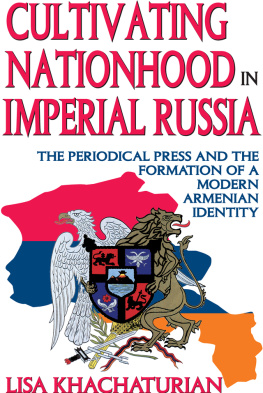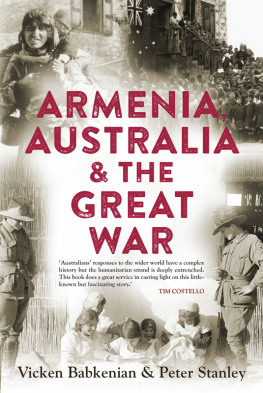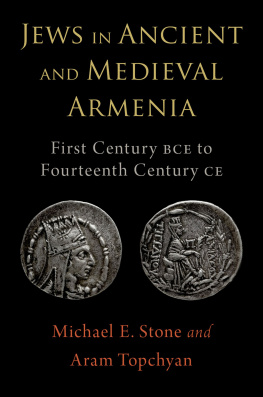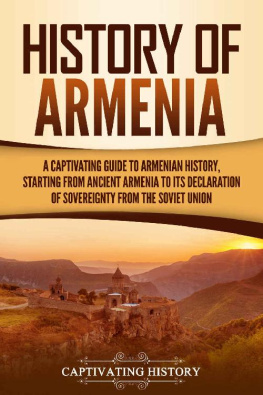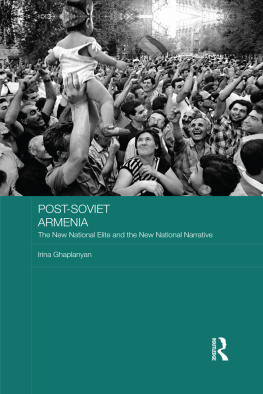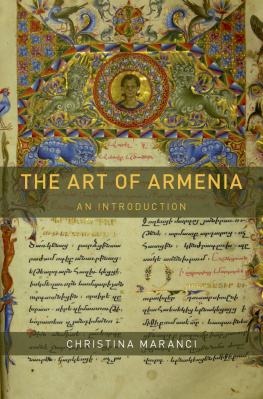MODERN ARMENIA
Modern Armenia
People, Nation, State
Gerard J. Libaridian
First published 2004 by Transaction Publishers
Published 2017 by Routledge
2 Park Square, Milton Park, Abingdon, Oxon OX14 4RN
711 Third Avenue, New York, NY 10017, USA
Routledge is an imprint of the Taylor & Francis Group, an informa business
Copyright 2004 by Taylor & Francis.
All rights reserved. No part of this book may be reprinted or reproduced or utilised in any form or by any electronic, mechanical, or other means, now known or hereafter invented, including photocopying and recording, or in any information storage or retrieval system, without permission in writing from the publishers.
Notice:
Product or corporate names may be trademarks or registered trademarks, and are used only for identification and explanation without intent to infringe.
Library of Congress Catalog Number: 2003054129
Library of Congress Cataloging-in-Publication Data
Libaridian, Gerard J.
Modern Armenia: people, nation, state/Gerard J. Libaridian
p. cm.
Includes bibliographical references and index.
ISBN 0-7658-0205-8 (cloth: alk. paper)
1. ArmeniaHistory1901- 2. ArmeniaHistory1801-1900.
3. Armenian massacres, 1915-1923. 4. TurkeyHistory20th century.
I. Title.
DS195.L52 2004
947.5608dc21 2003054129
ISBN 13: 978-1-4128-0648-0 (pbk)
ISBN 13: 978-0-7658-0205-7 (hbk)
To Nora
is a slightly adjusted version of an article first published in William O. McCagg, Jr. and Brian D. Silver, eds., Soviet Asian Ethnic Frontiers (Pergamon Press, 1979) under the title "Armenian and Armenians: A Divided Homeland and a Dispersed Nation."
, first published in Armenian Review, 3, 1983, is reproduced here with minor changes.
, first published in Richard G. Hovannisian, ed., Image of the Armenian in History and Literature (Undena, 1981), is reproduced with minor changes with the kind permission of the editor.
was first presented as a paper at the Symposium on Armenian History, University of Michigan, 1978.
, first published in Ronald G. Suny, ed., Transcaucasia:
Nationalism and Social Change (The University of Michigan Press, 1983 and 1996) as "Revolution and Liberation in the 1892 and 1907 Programs of the Dashnaktsutiune," is reproduced here with minor changes with the kind permission of the editor.
was first presented as a paper at the Middle East Studies Association Annual Meeting, University of California at Los Angeles, 1975.
, first published in Gerard J. Libaridian, ed., The Crime of Silence (Zed Books, 1985), reproduced in this volume with changes.
, first published in Isodor Wallimann and Michael N. Dobkowski, eds., Genocide and the Modern Age: Etiology and Case Studies of Mass Death (Greenwood Press, 1987), is reproduced here with minor changes with the kind permission of the editors.
was first published in Studia Kurdica, 1-5, 1988.
, originally presented as a paper at the First Turkish-Armenian Historians' Workshop, University of Chicago, March 2000, was first published in Insight Turkey, 4, 2000, and is being reproduced here with some changes.
was originally presented as a paper at the Second Turkish-Armenian Historians' Workshop, University of Michigan, Ann Arbor, March 2002, and is being presented here with substantial changes.
was first presented as a lecture at the Armenian Cultural Foundation, Arlington, Massachusetts, November 2002, and is being presented here with substantial changes.
A Note on Transliteration
Except for recognized authors of Western Armenian descent and traditionally accepted place names, Armenian names in this volume are transliterated based on Eastern Armenian phonetics.
Creating this volume has been a recurrent idea for more than a decade. The book combines a selection from previously published material, previously written but unpublished chapters, and the newly written last section.
The idea became compelling for two reasons. In the last few years I found myself repeatedly referring friends, colleagues, and students to articles on modern Armenian history published earlier in edited volumes and journals; it was infinitely more practical to bring together, complete, and offer in one place such materials that seemed to interest an audience.
With the first hesitant and tentative plan, I also realized that the collection represents, in fact, a whole in two ways. First, it became obvious that with some adjustments and additions, the collection would cover the most important events and issues in modern Armenian history. Also uniting the volume, it seemed, was the interpretive dimension of the various parts, predicated upon the continuous search to understand the paradoxes and contradictions, discontinuities, and silences that characterize that history.
Research that sustains sections on the earlier period was done for published as well as still unpublished work and dates back to the early 1970s. The section on the more recent period is based largely on my personal involvement in Diasporan organizations and the new Republic of Armenia. From 1991 to 1997 I had the privilege to work in the first administration of the new republic in a number of capacities. That fact might explain any biases some readers will find in my assessments.
I owe a debt of gratitude to many individuals who made this work possible at different stages of its preparation. Kami Libaridian, Taline Voskeritchian, Marine Nercessian, and, especially, Asbed Kotchikian provided invaluable technical and editorial assistance. I am most grateful to my wife Nora, my friends and publishers Irving L. Horowitz and Mary Curtis, and my editor, Michael Paley, without whose advice, aid, and encouragement this project would not have reached completion. Shortcomings, of course, remain my responsibility.
This volume consists of a series of essays initially written over a period of time which explore a few fundamental questions related to modern Armenian history: How have Armenians perceived politics, within the nation and in international affairs, at different stages of their history since the nineteenth century? Who has spoken for Armenians at different times and with what basis of legitimacy, especially when and where statehood was lacking? How and to what extent was the traditional sense of nationhood transformed into a modern one? How did the worldviews of political parties change Armenians' participation in the making of their own history and interact with forces and events beyond their control? What is the relationship between the notions of people, nation, and state in modern Armenian history? And, most importantly, what has been the significance of the "Turkish" factor in determining the limits and possibilities of Armenian political imagination?
Without claiming to present a comprehensive history of the period under considerationfrom mid-nineteenth century to the presentor to fill the gaps that still exist in the current literature, this volume will challenge a number of interpretations and perceptions on the way that history evolved. A history claiming to represent the life of a nation is as good as the questions that are asked by the historian. Reformulating a question will often bring out facts that were considered secondary, events that were forgotten, or processes that were considered insignificant. The purpose of this book is to ask a few good questions. Even if the answers are wrong, the book will still have served its purpose if they goad others to find the right ones.


